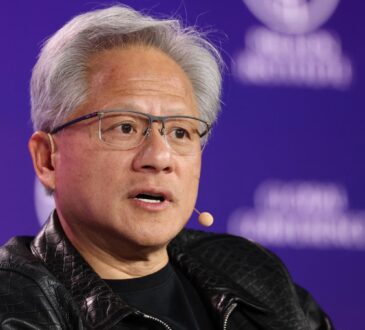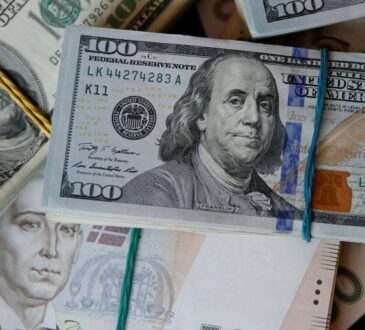The U.S. economy and stock market have outperformed. Can the American exceptionalism last?
The entire concept of “American exceptionalism” is controversial. Used by both major parties to advance their agendas of the moment, the belief that there’s something distinct and unique about America has been present for hundreds of years. It’s been co-opted by both boosters and detractors to explain away countless features of the U.S. landscape—from our high rates of gun violence and abnormal health care costs to our disdain for authority and penchant for self-reliance.
But while American exceptionalism may or may not be real in the political realm, it’s been front and center in the remarkable performance of the U.S. economy and stock market over the past few years. And almost nobody saw this exceptionalism coming.
The United States’ post-COVID rebound thoroughly surprised experts across the nation. Consult the economics textbooks, and the combined force of the worst inflationary wave since the 1980s and rapidly rising interest rates should have left the American economy looking worse for wear. Tack on two foreign wars that have crimped supply chains and boosted energy prices, and it makes sense why a U.S. recession was the near-unanimous expectation of many economists and Wall Street leaders for years.
Still, despite all these storm clouds, it looks like American consumers and businesses have so far defied the odds. The economy continues to grow, with a resilient labor market underpinning its largely unexpected success. And while serious cost of living issues remain, the U.S.’s post-COVID rebound has been particularly strong when compared to its developed peers.
In the fourth quarter of 2023, U.S. GDP grew at an annual rate of 3.3%, compared to just 0.1% for the 20 nations that make up the Euro Area, and 1.1% for Japan. And for all of 2023, U.S. GDP rose 2.5%, more than any other G7 economy, according to the International Monetary Fund’s (IMF) World Economic Outlook.
The economic strength has helped U.S. stocks trounce their developed market peers since the outbreak of COVID in early 2020. The S&P 500 is up over 53% since Jan. 2020, compared to a 16% rise for the STOXX Europe 600 index, a 52% jump for Japan’s Nikkei 225 (non-cap weighted), and a 23% drop for China’s CSI 300 index.
There are a few key reasons why the U.S. economy has outperformed in the post-COVID era, from the country’s relative energy independence to its aggressive fiscal and monetary response to the pandemic. They’re advantages that could help American stocks maintain their exceptional run of performance over the next few years.
“The U.S. is still in a better position than most other countries right now,” James Solloway, chief market strategist and senior portfolio manager at SEI Investments, told Fortune. “We’re seeing above average growth, which is somewhat surprising, but nonetheless, it’s happening. So we’ve entered 2024 with a bit of momentum.”
That being said, unpredictable risks, from the outcome of domestic elections to the impact of foreign wars, could still rear their head. And after U.S. stocks’ big run-up over the past few years, valuations are high. For investors, that means going all in on another era of U.S. stock market dominance may not be the best choice, even if the U.S. economy is set to outperform its developed peers. In this era of uncertainty, keeping all your eggs in one basket could be risky.
“I think that at this point, it pays to be diversified,” Solloway said. “The United States has had a great run, mainly owing to the growth nature of the stock markets here, but valuations have become quite stretched relative to other countries.”
Still, the U.S. may remain the global economy’s outlier in 2024—in a good way. And understanding why can help investors decide which way to go next, and how long this era of outperformance could go on.
A big fiscal response
When the outbreak of COVID-19 shut down the global economy in early 2020, the governments of developed nations took very different approaches to supporting their domestic economies. The U.S. federal government was by far the most aggressive with spending, dishing out $4.6 trillion, or roughly 10% of U.S. GDP in 2020 and 2021, through six COVID-19 relief laws.
SEI’s Solloway noted that not only did the U.S. have the largest fiscal response to the pandemic relative to the size of its economy, its COVID relief spending was also “much more direct, putting money into people’s pockets and supporting businesses directly, as opposed to just providing loan guarantees.”
This forceful fiscal response may have boosted inflation, Solloway said, but it also helped many Americans maintain their incomes during a period when spending was naturally lower. The combination of relatively stable incomes and lower spending helped consumers build up so-called “excess savings” during the pandemic. By August 2021, Americans had over $2 trillion in excess savings, and those savings helped buoy consumer spending and prevent a recession.
Resilience to rising interest rates
On the monetary side of things, the U.S. Federal Reserve was also very aggressive in cutting interest rates to near-zero when the pandemic hit. American consumers and businesses were quick to take advantage of the lower borrowing costs, refinancing mortgages and other loans while rates were historically low. That’s helped them recover from the brief COVID-induced downturn faster than anticipated, and maintain some spending power even as interest rates have risen.
“Households and businesses both had some insulation from the increase in rates… because both refinanced at very low interest rates,” Solloway said. “And therefore they have not immediately felt the impact of higher rates yet, as opposed to a lot of other countries.”
When central banks hike interest rates, it raises borrowing costs for all businesses and consumers—and that’s true in every country. But how quickly and severely higher borrowing costs affect consumers and businesses isn’t the same—a fact on display over the past few years with the U.S. Federal Reserve, the Bank of England, and the European Central Bank all raising rates.
Take housing. In the U.S., 79% of all mortgages had fixed rates of 30 or 15 years in 2023, according to Bankrate. Conversely, in the U.K., 74% of mortgages currently have interest rates that are fixed for two to five years before they need to be re-financed, according to data from the U.K.’s Financial Conduct Authority.
As a result, 55% of U.K. mortgages saw their interest rate increase since the end of 2021, the Guardianreported in December. But in the U.S., nearly 90% of homeowners still have mortgage rates under 6%, even as average 30-year mortgage rates spiked to 8% last year before falling to nearly 7%, Redfin data shows.
For many U.S. homeowners, it’s only when “their situation changes, they have a family, they need to move to a bigger house that they start feeling the impact of higher interest rates,” Solloway explained.
Energy independence
The U.S.’s relative energy independence compared to its developed nation peers is another reason it managed to outperform over the past few years.
U.S. natural gas production has soared in the past five years, hitting a record high in 2023. When Russia invaded Ukraine in February 2022, that meant the U.S. economy was more insulated from rising natural gas prices than many of its developed peers. European national gas prices, which are highly reliant on Russian gas, peaked at over over $70 per million British Thermal Units (BTU) in August 2022, compared to a peak of just $10 per million BTU in the U.S.
The U.S. energy industry has also developed a dominant position in the liquefied natural gas (LNG) market in recent years, with Europe increasingly relying on the U.S.’s LNG. Innes McFee, chief global economist at Oxford Economics, explained that Europe’s lack of energy independence “puts European industry at a structural disadvantage versus U.S. counterparts.”
On top of that, although the U.S. economy was affected by rising oil prices after the start of the Ukraine war, President Biden’s release of 180 million barrels of oil from the strategic petroleum reserve helped blunt the impact. U.S. energy companies were also able to rake in record profits as their production soared. That helped boost U.S. corporate earnings and stock prices, while providing high-paying jobs for many Americans.
U.S. oil production hit a record high in 2023 as well, and the U.S. Energy Information Agency expects “improved well productivity” will lead to two more record production years in 2024 and 2025. That should help prevent another oil price spike that could exacerbate inflation.
Will the U.S. continue to outperform?
The factors described above are just a few of the many that experts offer to explain the U.S. economies’ post-COVID outperformance. Other economists point to the U.S.’s more developed capital markets, saying they enable U.S. businesses to readily access cash in tough times, and have helped employers hang onto workers. Still more say U.S. tech dominance has made the American economy and stock market the major beneficiary of the AI boom. And others note that the direct support for American consumers in the form of stimulus checks led to a wave of new business formation and the upskilling of workers in the U.S. during the COVID era, which has worked to increase productivity and economic growth ever since. All of this doesn’t even touch on the domestic economic problems that other developed nations are facing—particularly China, with its ailing housing market.
Bank of America Research, whose own economists predicted a recession only to be happily surprised by the U.S. economy’s strong performance, have another idea about what could be driving the U.S. stock market: investors’ “FOMO.” The Global Equity Derivatives Research team, led by Benjamin Bowler, wrote in its 2024 outlook that “fear of missing out” was “winning the war in investors’ minds” over the many material fundamental and policy risks adding to larger macro uncertainty.
The “FOMO” term is a millennial standby, invented in 2004 by a Harvard Business School student writing an opinion piece in the school magazine. But the sentiment recalls similar euphemisms for investor enthusiasm from decades before: “irrational exuberance” was Fed chair Alan Greenspan’s parlance in the 1990s, and “animal spirits” was the preferred description from legendary economist John Maynard Keynes in the 1930s. Too much of this kind of thing can create bubbles that suddenly burst, just as it did during the dotcom bust, finishing off the Greenspan-era irrational exuberance.
The real question, however, remains: can the U.S.’ run of good form last? Some of the drivers of the current strength are also potential liabilities. Dependence on tech monopolies and deficit spending could trigger a painful correction. Similarly, fading excess savings and the high cost of living could dampen consumer confidence, stifling growth. But according to Oxford Economics’ McFee, “the outlook for the U.S. is actually still pretty good relative to other peers in developed markets.”
McFee forecasts 2.5% real income growth in the U.S. this year, which should help support consumer spending, compared to just 1% in Europe. He also expects fiscal policy to be “much more supportive” in the U.S. than in Europe, where the trend is toward “consolidation and reining in budget deficits.”
“The supply side of the U.S. economy looks a bit stronger. And you’ve seen really strong productivity growth in the U.S. this year— that’s not really the case elsewhere,” he added. To his point, IMF economists are forecasting 2.1% GDP growth for the U.S. economy in 2024, more than any other G7 economy.
All of that being said, McFee warned that the presidential election year creates one “big question” that will be key to determining the economy’s future.
“What will policy look like after the election?” he asked. “We’ve got the Trump tax cuts expiring next year. So there’s a really big opportunity to shape tax policy in the next administration. And I think that will have a big influence on whether or not the U.S. can continue to outperform other developed markets.”
SEI’s Solloway agreed that the election creates a lot of “uncertainty” in 2024, but added that the U.S. economy has another feature that should help it thrive no matter who is in office. “You know, the U.S. economy and investors adapt, even in harrowing times,” he noted. “We’ve actually seen a very good economy, and we’ve seen a very good stock market, during some very trying times over the last decade-plus.”




